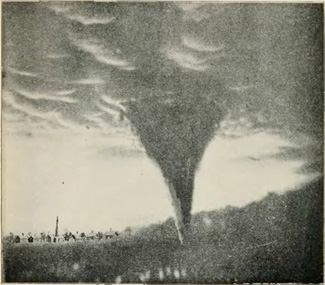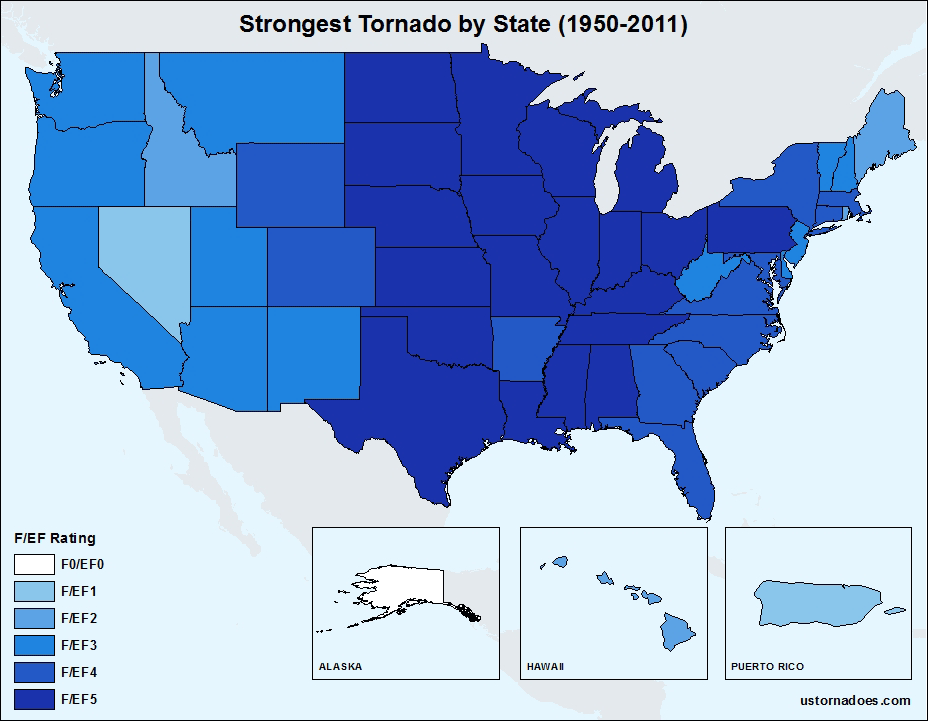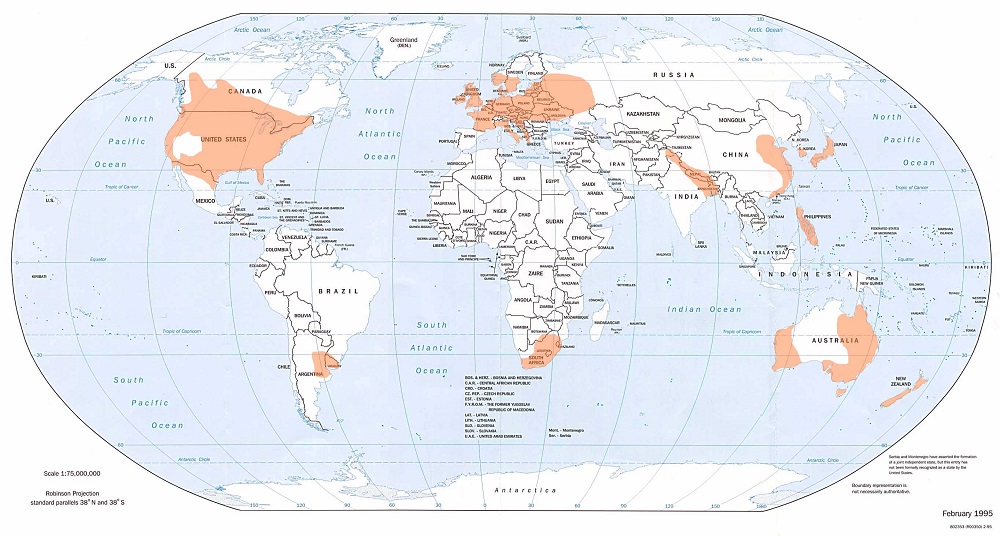
For much of the mid-1800s, the Smithsonian Institution in Washington, D.C. was the center of weather observation for the United States. Major tornado disasters during the spring and summer of 1860 resurfaced previous concerns about tornadoes, and by 1862 the Smithsonian distributed circulars alerting people to their dangers.
Included in the circulars was a questionnaire for those who ended up witnessing a tornado with a note urging them to return their detailed observations to the Smithsonian for further analysis. Sure enough, a number of replies came in, helping to further expand knowledge and the early science of tornadoes.
A full reproduction of the Smithsonian Institution’s “Queries Relative to Tornadoes” follows.
Queries Relative to Tornadoes
1. State the localities over which the storm extended—in the new States, trace the route on the quarter-sections of the U.S. Land Surveys.
2. State the date of the occurrence of the storms and the precise time of day (or height of sun) of its passing over different places.
3. State the width of the track at different places, specifying how wide that portion of it was where the most violent effect was produced; and what was the nature of this effect on the surface of the ground—for example, was the surface beaten flat, or was it furrowed.
4. Give the shape, color, and velocity of the storm-cloud, and also general appearance of the clouds in other parts of the sky, previous to, and at the immediate passage of the Tornado.
State whether some of these clouds were of a (dull) grayish color, while others of a (bright) white color :—whether these differently colored clouds were in opposite parts of the sky—or whether they were in two distinct layers, one above the other—what was the color of the layer (or stratum) which was the higher—how did they appear to be moving—towards or away from each other—and how did the lightning, if any, appear to pass from them—to each other, or the earth.
5. State the direction and force of the wind, before and after the passage of the Tornado—and whether it blew steady or in gusts.
6. Describe the thunder and lightning observed—whether the thunder was sudden or prolonged—and the lightning, whether zigzag, forked, or sheet—and what was its color.
7. Was there accompanying rain, or hail, immediately in the main track of the Tornado—and was there any at a distance—if so, how far off, on each side of the track.
8. Was the day unusually warm, sultry, or not :—were there observed any effects of the superabundance of moisture in the atmosphere—such as deposition on walls and on furniture in basements and other cool places, rendering them wet or clammy to the couch.
9. State the character of the weather for some time preceding and following the storm—and, particularly for the few days immediately preceding :—whether it was dry or wet, warm or cool.
10. Give the damage done to life and property :—full statistics of this, between specified points on the storm, are desirable.
11. State the manner and direction to which the wall and roofs of buildings appear to have been struck, and to have fallen, or to have been carried away :— whether portions of buildings were twisted around upon their foundations—and whether, in the case of some buildings where the doors and windows are known to have been closed at the time of the storm’s passage, the walls or roof were thrown down as if by an explosion outwards. Careful sketch drawings of any of the appearances will be valuable.
12. Give any cases of the stripping of feathers from fowls, and the clothes from persons :—also the manner in which furniture and materials of houses, barns, &c., were destroyed or carried off, and in what direction, and to what distance.
13. Did any of the persons in the immediate vicinity of the Tornado, at its passage, experience any peculiar sensations :—any shock, numbness in the limbs, loss of hearing, peculiar smell, feeling of cold, &c., &c.—and how long did these effects last.
14. Was anything unusual perceived in regard to the wounds of the persons or animals injured: were they difficult to heal, and was there anything unusual in the appearance of the bodies of the killed.
15. State any facts observed as to the direction in which the trees were thrown down, or broken off, on the south side of the track.
16. What effects were produced on the trees—whether broken off at the trunk, uprooted, or twisted around—or separated into splinters: did the sap remain in the wood, or was it dried up or evaporated :—what effect was produced on the bark, and what on the branches and leaves :—did any of the leaves present the appearance of having been scorched.
17. Were there any well-authenticated instances of hay, straw, or gain-stacks, or stables, or other buildings having been set on fire by the lightning, during the passage of the storm.
18. Was any case noticed of iron or steel which exhibited marks of heating or of mechanical action—if so, describe appearance.
19. Were there any side-currents towards, or off-shoots from the main course of the Tornado: and where did these commence and terminate.
20. State what was observed in regard to the whirl of the Spout or funnel-shaped cloud :—the direction if its rotation on its axis, whether “with the sun,” that is, in the direction of the hands of a watch when placed face upward—or “against the sun,” that is, opposite to that of the hands of a watch.
21. What was the color and general appearance of the Spout: was it always in contact with the ground, or did it sometimes rise up and again descend :—was it perpendicular or nearly so to the earth’s surface, or was it curved or inclined in the whole or part of its length, and in which direction :—was it of uniform diameter or varying :—what was its apparent height as compared with buildings, trees, or other objects it passed over—and how did it seem to be connected with the clouds above it.
If more than one Spout was in sight at the same time, describe their relative appearances and motions.
A sketch (however rough, if accurate) of the appearance of the Spout will be valuable, as also of its changes in figure, as it moved onward—thus :—
22. Were branches, limbs, or trunks of trees, articles of clothing, pieces of furniture or of wagons, or of houses observed carried up in the Spout—if so, how did they appear to be moving—how high and how far did they go—and in what manner were they dropped, whether gently or with violence.
23. Was the onward speed of the Spout uniform, or observed to vary :—did the track it left on the surface of the ground spread out or contract in width at different parts of its course, particularly near rivers and creeks :—and what effects were observed to be produced on the surfaces of water, while it was passing over them.
24. Did any detached clouds appear to move towards the Spout—in what manner did they join it—did they increase its dimensions, or did they appear to be condensed in it.
Did any clouds appear to move off from the Spout.
25. Was any lightning observed in the Spout itself, as well as in the accompanying main storm cloud from which the Spout usually is seen to hang down.
What was the character of this lightning—was it a glow of light—a discharge along the length of the Spout—or transverse—or was it globular in appearance.
**Brief answers to even a part of these queries, sent to the Smithsonian Institution, Washington, D.C., may be of importance, and will be thankfully acknowledged.**
This Smithsonian Institution questionnaire was reproduced in its entirety as found in Early American Tornadoes 1586-1870 (David Ludlum), pp. 156-157. Inset image of the tornado at the beginning of the post is from an “Illustration in History of Iowa From the Earliest Times to the Beginning of the Twentieth Century.”
Get updates about U.S. Tornadoes on Twitter and Facebook.
Latest posts by Ian Livingston (see all)
- Busy March for twisters to end with another multi-day event - March 28, 2025
- Everything but locusts: NWS shines in apocalyptic weather - March 17, 2025
- Top tornado videos of 2023 - January 1, 2024

